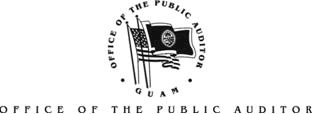
FY 2003 Financial Highlights
August 10, 2004
According to the FY 2003 Guam Telephone Authority (GTA) financial statements audited by Ernst & Young LLP, GTA incurred a $9.7 million loss for FY 2003, doubling from a $4.9 million loss in FY 2002. This loss is attributed to the following reasons:
- Inventory loss of $2.4 million
Per Finding 2003-13, GTA purchased inventories from a “middleman” vendor instead of a direct distributor. This procurement was done on a “sole source” basis, which resulted in GTA paying for inventories that were $2.4 million more than the actual market value of the inventories purchased; a price that was 1357% higher than the market price. Because GTA’s inventory must be valued at lower of cost or market, GTA incurred a write down in the value of their inventory and recognized a loss of $2.4 million. This sole source procurement occurred under the former administration. For the last three fiscal years, GTA paid over $7.4 million to this middleman; $643,000 in FY 2003, $3.3 million in FY 2002, and $3.5 million in FY 2001. All but $128,000 was paid under the previous General Manager.
- Decline in operating revenues by $1.4 million
Although revenues for long distance network services increased by $2.4 million, all other sources of revenues declined, resulting in an overall decline in revenues of $1.4 million. In addition to the decline, GTA also wrote off $2.8 million in receivables.
- Typhoon casualty loss of $4 million
In December 2003, Guam was devastated by Typhoon Pongsona, which caused GTA to incur over $4 million in casualty losses.
GTA’s operational costs for FY 2003 decreased by $3 million primarily due to minimal privatization costs. Privatization expenses, however, are expected to resurface in FY 2004.
GTA is required by the Rural Telephone Bank (RTB) Supplemental Indenture to maintain an average Times Interest Earned Ratio (TIER) of 1.5. TIER is calculated by taking the sum of GTA’s Net Income and Interest Expense and dividing it by the Interest Expense. This would show whether GTA has sufficient working capital to meet its obligations.
For FY 2003, GTA’s TIER was “-.61” (negative), a dramatic decline from FY 2002’s TIER of .22. Fortunately, because the TIER is presented as an average, GTA’s average TIER for FY 2003 was boosted to .89, a figure still below the required ratio. Based on the low TIERs for FY 2002 and FY 2003, the average TIER for FY 2004 can be expected to plummet significantly. GTA does not expect the TIER to increase until FY 2005.
The Compliance and Internal Control Reports documented a total of 43 findings, 26 of which are repeat findings from the previous year. Seven (7) findings pertained specifically to procurement. Nine (9) findings pertained to receivables. One of those findings showed at least $2 million (76%) in receivables for landline services were outstanding for more than 120 days. Similarly, $600,000 (77%) of receivables for cellular services were outstanding for more than 120 days. These outstanding receivable balances show that it is unlikely that GTA would be able to collect payments from these accounts.